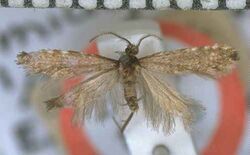Biology:Reductoderces microphanes
| Reductoderces microphanes | |
|---|---|

| |
| Male holotype specimen | |
| Scientific classification | |
| Kingdom: | Animalia
|
| Phylum: | |
| Class: | |
| Order: | |
| Family: | |
| Genus: | |
| Species: | R. microphanes
|
| Binomial name | |
| Reductoderces microphanes (Meyrick, 1888)[1]
| |
| Synonyms[2][3] | |
| |
Reductoderces microphanes is a moth of the family Psychidae.[1] This species is endemic to New Zealand. R. microphanes is a bagworm moth and its larvae likely feed on lichen or algae. Historically there has been some confusion over the identification of this species with George Hudson mistakenly describing and illustrating unnamed species and then attributing those descriptions and illustrations to this species. Charles Edwin Clarke discussed this species stating that it and its close relatives were active and able to be collected in damp mists before sunrise.
Taxonomy
This species was first described by Edward Meyrick in 1888 using a male specimen collected in Christchurch in August and named Mallobathra microphanes.[4] In 1915 Meyrick revised New Zealand Tineina and maintained this placement.[5] In 1928 in his book The butterflies and moths of New Zealand, George Hudson discussed and illustrated moths purporting to be this species under the names Taleporia microphanes and Mallobathra fragilis.[6] In 1971 J. S. Dugdale removed this species from the genus Taleporia and placed this species within the genus Reductoderces.[7] In 1988, J. S. Dugdale stated that both descriptions and illustrations by Hudson of Taleporia microphanes and Mallobathra fragilis in his 1928 book The butterflies and moths of New Zealand referred to unnamed species rather than to Reductoderces microphanes.[2] In 1988 Dugdale also synonymised Mallobathra fragilis with Reductoderces microphanes.[2] The placement by Dugdale of this species into the genus Reductoderces was confirmed in the Inventory of New Zealand Biodiversity.[1] The holotype specimen is held at the Natural History Museum, London.[2]
Description
Meyrick described the species as follows:
Male. — 9 mm. Head, palpi, and antennae light fuscous ; palpi moderate ; antennal ciliations 2 1⁄2. Thorax fuscous. Abdomen grey. Legs grey-whitish. Forewings elongate, costa slightly arched, apex rounded, hindmargin extremely obliquely rounded ; rather dark fuscous, irrorated with very obscure grey-whitish spots ; costa with four more distinct small white spots on posterior half: cilia whitish-fuscous, basal half except towards anal angle fuscous obscurely spotted with whitish. Hindwings light grey ; cilia 1 1⁄2, grey-whitish.[4]
Distribution
This species is endemic to New Zealand.[1][8] It has been collected in its type locality of Christchurch as well as in Dunedin.[5][9]
Behaviour
Charles Edwin Clarke stated that the adults of this species are active and able to be collected in damp mists before sunrise.[10]
Host species and habitat
It is likely that the larvae of this species are lichen or alga-browsers.[7] The larvae of this species inhabit long, flanged cases which can be found on cliff-faces, tree trunks or stones.[7]
References
- ↑ 1.0 1.1 1.2 1.3 , pp. 463, Wikidata Q45922947
- ↑ 2.0 2.1 2.2 2.3 , pp. 69, Wikidata Q45083134
- ↑ "Reductoderces microphanes (Meyrick, 1888)". https://nzinverts.landcareresearch.co.nz/default.aspx?selected=NameDetails&NameId=477E72B2-850F-4D8B-9AF8-E238FF876091&StateId=&Sort=0&TabNum=1.
- ↑ 4.0 4.1 , pp. 103, Wikidata Q63125188
- ↑ 5.0 5.1 , pp. 240, Wikidata Q63123349
- ↑ , Wikidata Q58593286
- ↑ 7.0 7.1 7.2 , pp. 141, Wikidata Q64006453
- ↑ "Reductoderces microphanes (Meyrick, 1888)". https://www.nzor.org.nz/names/0e15b6b8-36c0-40c0-b300-01c06c4ccfcf.
- ↑ , pp. 238, Wikidata Q63958657
- ↑ , pp. 115, Wikidata Q62934927
Wikidata ☰ Q15640202 entry
 |

